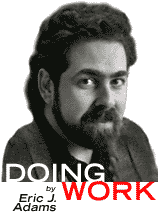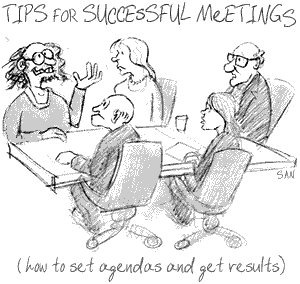 |
|
||||||||||||
|
Columns by Eric J. Adams Beyond the Fruitcake: Holiday Gift Giving Tips for IPs Beyond the Honeymoon: How to Nurture Client Loyalty in the Age of Corporate Infidelity Protect Yourself From Finger Pointers: Blaze a Trail How to Build Winning Recommendations Handling the End of the Relationship Dealing With Nightmare Clients
Visit our regular Doing Work columnist, Peter Economy
|
I remember the day clearly. I was about to sign with a major talent agency after writing a novel and screenplay. My first real meeting was to take place over lunch at a chic Beverly Hills restaurant, the kind where winks and nods ricochet around the room, and there are bubbles in all the water. I was young, naive, and confident, and I thought this was a simple get-together lunch. I was wrong. Dead wrong. My agents came with an agenda -- and I didn't. Consequently, by the end of the meeting, I had pretty much agreed to all their contract points and walked away feeling, as Led Zeppelin used to say, dazed and confused. It took me weeks to figure out what I should have proposed and counter-proposed. And worst of all, I know they came away with the perception that I was green in the world of meetings, not the best color to wear in the Hollywood big leagues. That day, I made a pact with myself to never again go into a meeting without an agenda that includes what I want to cover and the outcomes I'm aiming for. I've since left that world, but I've gotten even more fanatic about meetings. Check out these statistics: the average CEO spends about 17 hours each week in meetings, according to The Wharton Center for Applied Research. Senior executives spend an average of 23 hours a week in meetings, and middle managers spend 11 hours. What's more, senior and middle managers say that only 56% of meetings are productive; a phone call or a memo could replace over 25% of the meetings they attend. But you're an IP -- so why should you care? First, many of you meet with these people all the time, and if you can be the agent of effective meetings, you'll save them time and money -- and, boy, will they appreciate it. Second, and more importantly, as an IP you have no one but yourself to look out for your own interests. Unless you go into meetings aware of what you want, you run the risk of being taken advantage of. A good meeting, like a football team's huddle, should bring the players together, facilitate decision making, assist people in taking responsibility, energize the participants, and contribute to building team effort within the organization -- all as quickly as possible. And, of course, it should produce results. Running, and even participating, in a good meeting is both an art and a science. You have to keep it moving, keep it on target, and yet make sure people don't feel hurried and unheard. Every meeting you attend can become more effective if you pay attention to three areas: content, design, and process. 1. Content. There's a church in my town that posts little sayings on its marquis every week. This week it says: "There's no right way to do the wrong thing." And so it is with meetings. You can't make the right decisions if the wrong items are discussed. The key to content is to focus meetings around key issues. Sometimes it takes a lot of work before a meeting just to figure out what those key issues are. Sometimes the work simply has to be done in the meeting itself. Just never lose sight of the "what" of your meeting. Make sure each and every meeting is justified. And to make sure everyone else feels that your meetings are justified, type up an outline of agenda items beforehand and email them around or pass out hard copies (bring a few extra along for stragglers). A whiteboard helps to keep agenda items in plain view. If you want to get fancy, try a PowerPoint presentation, though your client may feel you're wasting a lot of time and money on presentations rather than on the challenges and opportunities at hand. 2. Design. We've all been here before. A meeting starts well enough; then suddenly people start talking about a later agenda item or they bring up new items out of the blue. The meeting quickly degenerates until there's no way a decision can be made about anything. In designing a meeting, figure out how you want to approach each agenda item. Each item on the agenda requires an accompanying implementation method. Use the tried-and-true stand-up-and-report method when you need to update a big group on your latest project. Brainstorming is great for ideas that need to be flushed out. And problem-solving techniques work well with particularly irascible dilemmas. Tailor your methods to the kind of content being discussed and you'll masterfully move the meeting along and get resolution on each item. 3. Process. Here's where you really have to think on your feet. Are people participating? Do they feel there is room for their ideas? Are dysfunctional behaviors openly dealt with? Is there positive energy in the group? Are people committed to the task at hand and enthused about the way the group is working to complete the task? A meeting, needless to say, is a dynamic process that can be positive or negative. You can help by checking in with "the quiet ones" during the meeting, or discussing meeting dynamics before or after the meeting with people you feel are having problems. You can improve the process by making sure that one idea is discussed at a time, and that everyone is in agreement as to how decisions will be made. If you pay attention to the content and design of your meeting, you can bet you'll have far fewer problems with process. Even if you're not the facilitator, you can help move meetings along by keeping an eye on content, design, and process. If you do, chances are more of your goals and desires will be met. |
|
|
We'd love to hear your feedback about this column, or put you in touch with Eric J. Adams if you like. You may also like to see his biography. |
The 1099 name and logo are trademarks of 1099 Magazine.

